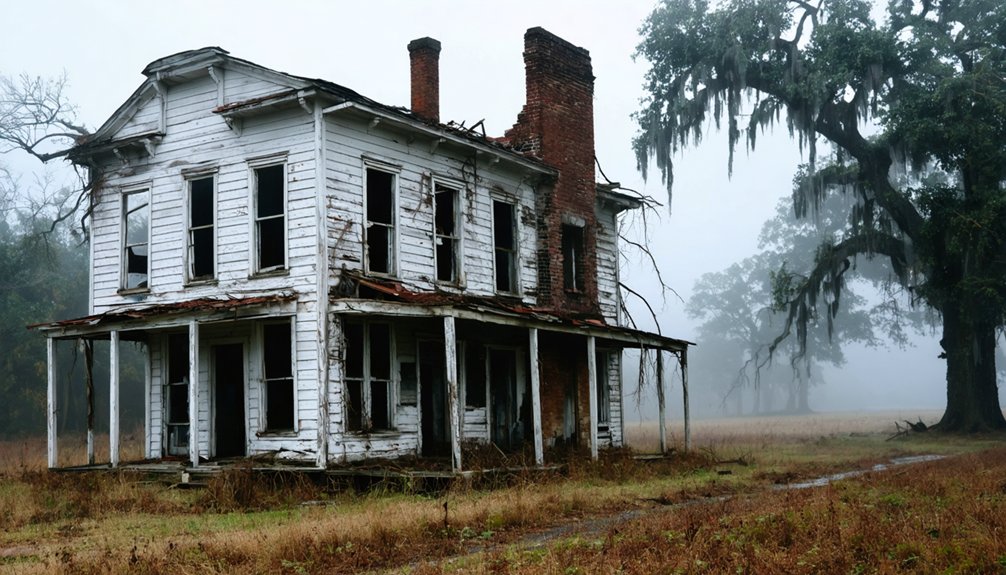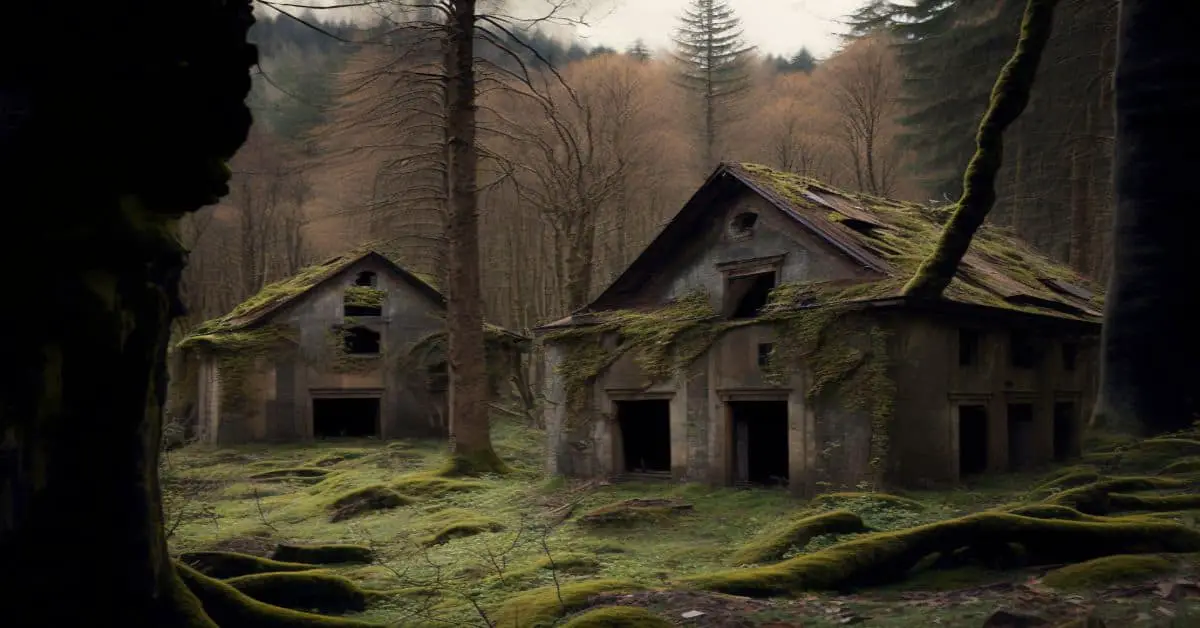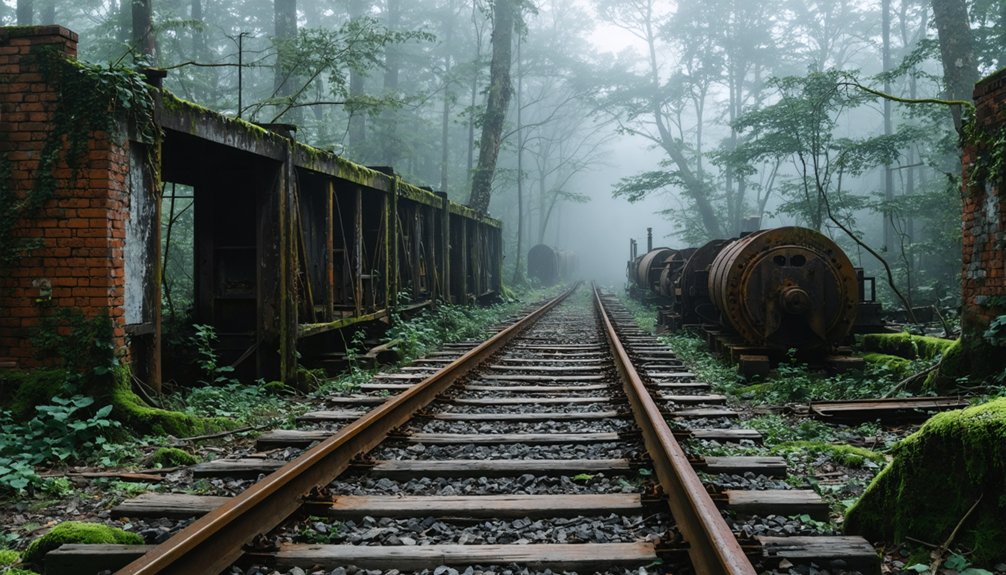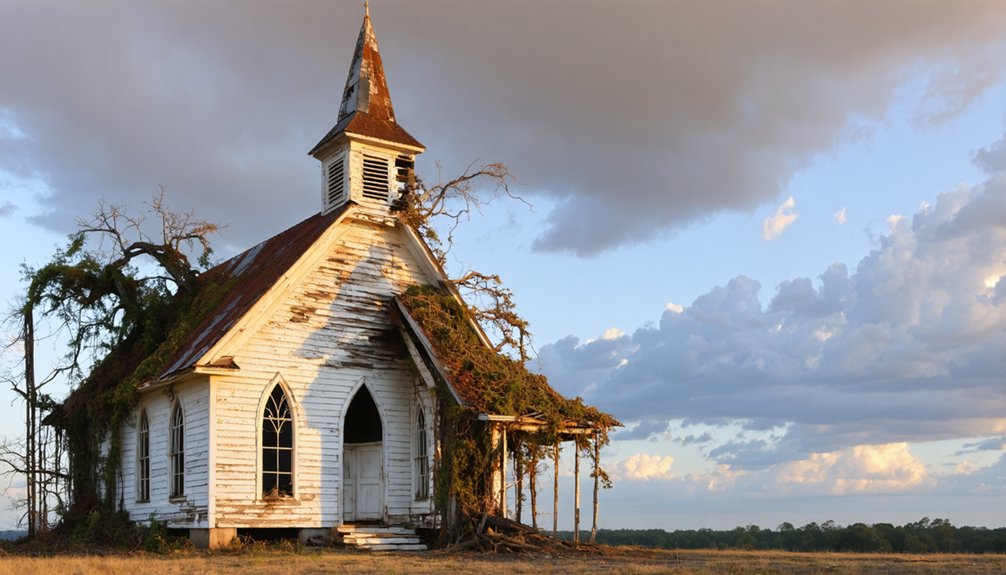You’ll find Apalachee, Georgia’s ghost town north of Madison, where brown railroad tracks weave through quiet rural landscapes. Once called Dogsboro before 1820, it transformed into a thriving agricultural hub after the Florence Depot’s arrival in 1888. The town features preserved Folk Victorian architecture, including a historic schoolhouse and two churches from the 1800s. Today’s peaceful setting, marked by abandoned railways and weathered buildings, holds stories of its bustling railroad past.
Key Takeaways
- Once a thriving railroad town established in 1888, Apalachee declined from a bustling commercial center into a present-day ghost town.
- Historic landmarks including the Baptist Church (1857), Methodist Church (1923), and schoolhouse remain as testament to its past.
- The town’s transformation from Dogsboro to Apalachee coincided with the Florence Depot construction and railroad development.
- Agricultural heritage is evident through remnants of cotton gins and oil refineries that once drove the local economy.
- Brown railroad tracks wind through the rural landscape, offering visitors opportunities to explore this well-preserved piece of Georgia history.
The Birth of a Railroad Town
Though the area around Apalachee was settled before 1820 as one of Morgan County’s oldest communities, the town’s true birth came with the arrival of the railroad in 1888.
The early settlers initially called the area Dogsboro, but that would change with the construction of Florence Depot, which later became known as Apalachee.
The town became a center for agriculture, operating a cotton gin and cotton oil refinery for local farmers.
The railroad’s arrival transformed this quiet rural community into a bustling transportation hub.
The town grew to include three general stores and several other thriving businesses that served the local population.
You’ll find that this pivotal moment in railroad history set the stage for Apalachee’s rapid development, leading to its official incorporation in 1907.
The addition of a second railroad line that same year, built by John Bostwick to connect Apalachee with the town of Bostwick, cemented the community’s position as an essential transportation crossroads.
Life Along the Apalachee River
Beyond the railroad tracks that shaped Apalachee’s growth, the life-giving Apalachee River carved its path through the region’s fertile bottomlands.
Originally known as Tulapocca River, this waterway would later take on its current name around 1790.
You’ll find evidence of the river’s profound influence on both indigenous peoples and early settlers who called these waters home. The river ecosystems supported diverse wildlife and plant life, while controlled burns by Native Americans transformed the surrounding longleaf pine forests.
Creek families settled in the fertile valleys, harvesting indigenous resources and establishing trade networks along the waterway. The native inhabitants cultivated corn, beans, and squash in the rich soil, following agricultural traditions that sustained their communities for generations. By the early 1800s, you’d have seen dispersed farmsteads taking advantage of the rich alluvial soils, with cotton plantations and processing facilities emerging as agriculture expanded.
The river served as both sustenance provider and transportation corridor, linking communities and fostering commerce throughout the region’s development.
Historical Landmarks and Architecture
Despite its ghost town status today, Apalachee’s architectural heritage tells a rich story through its surviving landmarks.
You’ll find the historic schoolhouse standing as a symbol of the community’s educational past, while both the Apalachee Baptist Church (1857) and Methodist Church (1923) remain anchors of spiritual life.
The town’s architectural significance is evident in its Folk Victorian cottages and old storefronts bearing family names that line the streets. A distinctive two-door house reflects the unique multi-family living arrangements of early residents.
The area was once part of the ancient Temple of Amana, where North America’s first major gold rush began in 1828.
Along the disused railroad tracks that once brought prosperity, you’ll discover remnants of Apalachee’s commercial heyday.
Historic preservation efforts have helped maintain these structures, including the placement of a Morgan County Bicentennial Historic Marker in 2007.
The small cemetery, featuring graves of the Shockley and Prior families, provides a tangible connection to the town’s early settlers.
Cultural Organizations and Community Spirit
During its early 20th-century peak, Apalachee’s vibrant cultural life centered around several active societies that shaped the town’s social fabric.
You’d find the Glee Club and Players’ Club bringing music to life through vocal performances and live entertainment, while the Literary Club offered a space for intellectual discourse and personal growth.
The Apalachee Improvement Club took on civic responsibilities, likely spearheading town beautification and infrastructure projects. Much like the stratified society of the indigenous Apalachee people, these organizations maintained distinct roles and responsibilities.
These organizations reflected a strong commitment to cultural engagement and community identity in this small railroad town.
Apalachee’s social clubs embodied the spirit of a town that valued both cultural enrichment and strong community bonds.
While membership numbers aren’t known, the presence of multiple thriving groups points to robust participation.
Though these societies eventually disbanded as Apalachee declined by mid-century, they’d left an indelible mark on the town’s character, representing an era of purposeful civic involvement.
Similar to today’s Daughters of the American Revolution, these groups focused on preserving heritage while making meaningful contributions to their community.
The Railroad Era’s Economic Impact
When the railroad arrived in Apalachee in 1888, it transformed the town’s economic landscape from an isolated rural community into a vibrant commercial hub.
You’d have witnessed significant railroad expansion in 1907 when John Bostwick built a second line, connecting the town to broader markets and transportation networks.
The economic transformation was remarkable. By 1920, you could find three general merchandise stores, a cotton gin, cotton oil refinery, and seed house in town.
The railroads didn’t just move cotton – they brought new opportunities for trade and industry. You’d see goods flowing between Apalachee and major cities like Atlanta, Augusta, and Chattanooga, while the improved transportation helped local businesses thrive by reducing costs and expanding their market reach. Similar to Georgia’s early state-owned railroad, the railway system connected Apalachee to the humid subtropical climate of East Tennessee, enabling year-round commerce regardless of weather conditions.
From Bustling Hub to Quiet Memories
As the mid-20th century approached, Apalachee’s vibrant community life began fading into quiet memories.
You’ll find evidence of community decline in the 1950s closure of the post office, followed by shuttered businesses and abandoned commercial buildings. Where cultural groups once thrived – the Glee Club, Players’ Club, and Literary Club – silence now prevails.
Today, you can trace cultural nostalgia through the town’s enduring landmarks.
Silent monuments of brick and stone stand witness to bygone days, each building a chapter in our collective memory.
The Gothic Revival Baptist Church, built in 1857, and the 1923 Methodist Church stand as silent sentinels of a more prosperous era. The massive 1911 schoolhouse, though empty, reminds you of bustling classrooms and community gatherings.
Overgrown railroad tracks weave through the landscape, telling stories of a once-thriving transport hub now transformed into a peaceful rural retreat north of Madison.
Frequently Asked Questions
Are There Any Guided Tours Available to Explore Apalachee’s Historic Sites?
You won’t find guided exploration of the site, as there aren’t any established tours available. You’ll need to discover the historical significance independently since no official tour operators serve this location.
What Happened to the Residents When the Town Declined?
Millions fled during the population decline, but you’ll find some families stayed put. Most residents migrated due to the boll weevil crisis, Great Depression, and failing railroads – while others adapted to farming.
Can Visitors Access the Abandoned Buildings and Photograph Them?
You’ll find exterior photography unrestricted, but don’t enter the unsafe structures. Urban exploration photographers can capture compelling shots of the deteriorating buildings from outside while respecting private property boundaries.
Does Anyone Still Maintain the Old Apalachee Cemetery?
You won’t find regular cemetery maintenance at the historic Apalachee site today. Despite its historical significance, upkeep falls solely to private landowners or descendants who might voluntarily care for individual graves.
Are There Any Annual Events or Festivals Celebrating Apalachee’s History?
You won’t find any dedicated festivals celebrating Apalachee’s history, though you might encounter historical reenactments and local folklore elements at nearby regional events like the Dancing Goats Folkfest.
References
- https://en.wikipedia.org/wiki/Apalachee
- https://vanishinggeorgia.com/category/apalachee-ga/
- https://www.freakyfoottours.com/us/georgia/
- https://sites.rootsweb.com/~gatttp/ghosttowns/apalachee/apalachee.htm
- https://thewanderwomanway.wordpress.com/2016/07/02/apalachee/
- https://www.johncloonan.com/georgia-ghost-town/
- https://www.ghosttowns.com/states/ga/apalachee.html
- https://www.youtube.com/watch?v=ob-QLvCbyQk
- https://www.cityofauburn-ga.org/m/HistoryofAuburn.aspx
- https://www.georgiaencyclopedia.org/articles/business-economy/railroads/



